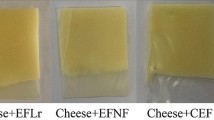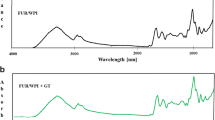Abstract
This study aimed to develop and characterize bioactive edible films (EFs) based on LAB-fermented whey solution and potato starch and evaluate their physical, mechanical, and probiotic count during storage. Fermented whey solutions with Lactobacillus acidophilus and Lactobacillus rhamnosus were mixed with potato starch solution (1:1 v/v) to produce EFs, which were evaluated in their moisture, color, thickness, tensile strength, water vapor permeability, and probiotic load at the beginning and after 14 days of storage (4 ± 1 °C) using PET and LLDPE as secondary packages. Selected EFs were evaluated in their antimicrobial activity against Escherichia coli and their viable cell count and structure using laser scanning confocal (LSC) and environmental scanning electronic micrographs (ESEM), respectively. The thickness (37.5–62.5%) and tensile strength (86.4–136.4%) of EFs increased by adding fermented whey in the film formulation (compared to control EFs), while moisture, color parameters, and elongation at break were not affected. The probiotic count obtained after the gastrointestinal process was higher (1.64–1.82 log) than the obtained in not digested EFs, indicating a liberation of trapped microorganisms during the gastrointestinal process. In general, the package did not affect the mechanical properties of EFs. The probiotic count was not affected by the package and storage time, showing a similar viable count in both plate counting and LSC. Micrographs indicated that LAB-fermented whey EFs showed smooth surfaces without breakups; however, after storage, a reduction in thickness and a fractured surface were observed. Stored LAB-fermented EFs showed antimicrobial activity (21–22 mm inhibition zone) against E. coli. Fermented EFs showed adequate stability to be applied in food products.




Similar content being viewed by others
Data Availability
The datasets obtained during the current study are available from the corresponding author upon reasonable request.
References
AOAC. (2000). Official methods of analysis of the association of official analytical chemists, 20th ed.; AOAC International: Washington, DC, USA.
Aparicio-Fernández, X., Vega-Ahuatzin, A., Ochoa-Velasco, C. E., Cid-Pérez, S., Hernández-Carranza, P., & Ávila-Sosa, R. (2018). Physical and antioxidant characterization of edible films added with red prickly pear (Opuntia ficus-indica L.) cv. San Martín peel and/or its aqueous extracts. Food and Bioprocess Technology, 11, 368–379.
ASTM. (1995). Standard test method for tensile properties of thin plastic sheeting; Method D882-American Society for testing and materials; ASTM: West Conshohocken. PA.
ASTM. (1980). Standard test method for water vapor transmission of materials; Method E96-American Society for testing and materials; ASTM: West Conshohocken. PA.
Basiak, E., Lenart, A., & Debeaufort, F. (2017). Effect of starch type on the physico-chemical properties of edible films. International Journal of Biological Macromolecules, 98, 348–359.
Basiak, E., Lenart, A., & Debeaufort, F. (2018). How glycerol and water contents affect the structural and functional properties of starch-based edible films. Polymers, 10, 412.
Ceylan, H. G., & Atasoy, A. F. (2023). New bioactive edible packing systems/symbiotic edible films/coatings as carries of probiotics and prebiotics. In Press.
Chen, W., Ma, S., Wang, Q., McClements, D. J., Liu, X., Ngai, T., & Liu, F. (2022). Fortification of edible films with bioactive agents: A review of their formation, properties, and application in food preservation. Critical Reviews in Food Science and Nutrition, 62, 5029–5055.
Díaz-Montes, E., & Castro-Muñoz, R. (2021). Edible films and coatings as food-quality preservers: An overview. Foods, 10, 249.
Espitia, P. J. P., Batista, R. A., Azeredo, H., & Otoni, C. G. (2016). Probiotics and their potential applications in active edible films and coatings. Food Research International, 90, 42–52.
Farajpour, R., Emam, Z., Moeini, S., Tavañolipour, H., & Safayan, S. (2020). Structural and physico-mechanical properties of potato starch-olive oil edible films reinforced with zein nanoparticles. International Journal of Biological Macromolecules, 149, 941–950.
Galus, S., Aytunga, E., Gniewosz, M., & Kraśniewska, K. (2020). Novel materials in the preparation of edible films and coatings- A review. Coatings, 10, 674.
Garavand, F., Jafarzadeh, S., Cacciotti, I., Vahedikia, N., Sarlak, Z., Tarhan, Ö., Yousefi, S., Rouhi, M., Castro-Muñoz, R., & Jafari, S. M. (2022a). Different strategies to reinforce the milk protein-based packaging composites. Trends in Food Science & Technology, 123, 1–14.
Garavand, F., Khodaei, D., Mahmud, N., Islam, J., Khan, I., Jafarzadeh, S., Tahergorabi, R., & Cacciotti, I. (2022b). Recent progress in using zein nanoparticles-loaded nanocomposites for food packaging applications. Critical Reviews in Food Science and Nutrition, 12, 1–21.
Garavand, F., Rouhi, M., Jafarzadeh, S., Khodaei, D., Cacciotti, I., Zargar, M., & Razavi, S. H. (2022c). Tuning the physicochemical, structural, and antimicrobial atributes of whey-bsed poly (L-lactic acid) (PLLA) films by chitosan nanoparticles. Frontiers in Nutrition, 9, 880520.
García-Anaya, M., Sepulveda, D. R., Zamudio-Flores, P., & Acosta-Muñiz, C. H. (2023). Bacteriophages as additives in edible films and coatings. Trends in Food Science & Technology, 132, 150–161.
Grujović, M. Z., Mladenović, K. G., Semedo-Lemsaddek, T., Laranjo, M., Stefanović, O. D., & Kocić-Tanackov, S. (2021). Advantages and disadvantages of non-starter lactic acid bacteria from traditional fermented foods: Potential use as starters or probiotics. Comprehensive Revies in Food Science and Food Safety, 21, 1537–1567.
Guimarães, A., Ramos, O., Cerqueira, M., Venãncio, A., & Abrunhosa, L. (2020). Active whey protein edible films and coatings incorporating Lactobacillus buchneri for Penicillium nordicum control in cheese. Food and Bioprocess Technology, 13, 1074–1086.
Guo, M., Zhang, C., Zhang, C., Zhang, X., & Wu, Y. (2021). Lacticaseibacillus rhamnosus reduces the pathogenicity of Escherichia coli in chickens. Frontiers in Microbiology, 12, 664604.
He, C., Sampers, I., & Raes, K. (2021). Dietary fiber concentrates recovered from agro-industrial by-products: Functional properties and application as physical carriers for probiotics. Food Hydrocolloids, 111, 106175.
Iversen, L., Rovina, K., Vonnie, J., Matanjun, P., Erna, K., ‘Aqilah, N., Felicia, W., & Funk, A.A. (2022). The emergence of edible and food-application coatings for food packaging: A review. Molecules, 27, 5604.
Jones, K. H., & Senft, J. A. (1985). An improved method to determine cell viability by simultaneous staining with fluorescein diacetate-propidium iodide. The Journal of Histochemistry and Cytochemistry, 33, 77–79.
Kalantarmahdavi, M., Khanzadi, S., & Salari, A. (2021). Edible films incorporating with Lactobacillus plantarum based on sourdough, wheat flour, and gelatin: Films characterization and cell viability during storage and simulated gastrointestinal condition. Starch, 73, 2000268.
Kumar, L., Ramakanth, D., Akhila, K., & Gaikwad, K. (2022). Edible films and coatings for food packaging applications: A review. Environmental Chemistry Letters, 20, 875–900.
Mahmud, J., Sarmast, E., Shankar, S., & Lacroix, M. (2022). Advantages of nanotechnology developments in active food packaging. Food Research International, 154, 111023.
Misra, S., Pandey, P., Dalbhagat, C. G., & Mishra, H. N. (2022). Emerging technologies and coating materials for improved probiotication in food products: A review. Food and Bioprocess Technology, 15, 998–1039.
Modiri, S., Kasra, R., Reza, M., Dad, N., Ebadi, M., Shahbani, H., & Akbari, K. (2021). Growth optimization of Lactobacillus acidophilus for production of antimicrobial peptide acidocin 4356: Scale up from flask to lab-scale fermenter. Iran Journal of Biotechnology, 19, e2686.
Mohammadi, R., Sohrabvandi, S., & Mohammad, A. (2012). The starter culture characteristics of probiotic microorganisms in fermented milks. Engineering in Life Sciences, 4, 399–409.
Nanda, S., Patra, B., Patel, R., Bakos, J., & Dalai, A. (2021). Innovations in applications and prospects of bioplastics and biopolymers: A review. Environmental Chemistry Letters, 20, 379–395.
Nisar, T., Alim, A., Iqbal, T., Iqbal, M., Tehseen, S., Zi-Chao, W., & Guo, Y. (2021). Functionality of different probiotic strains embedded in citrus pectin based edible films. International Journal of Food Science and Technology, 57, 1005–1015.
Ochoa-Velasco, C. E., Palestina-Rivera, J., Ávila-Sosa, R., Navarro-Cruz, A. R., Vera-López, O., Lazcano-Hernández, M., & Hernández-Carranza, P. (2022). Use of green (Opuntia megacantha) and red (Opuntia ficus-indica L.) cactus pear peels for developing a supplement rich in antioxidants, fiber, and Lactobacillus rhamnosus, 42, e101421.
Osés, J., Fernández-Pan, I., Mendoza, M., & Maté, J. I. (2009). Stability of the mechanical properties of edible films based on whey protein isolate during storage at different relative humidity. Food Hydrocolloids, 23, 125–131.
Piccirilli, G. N., Soazo, M., Pérez, L. M., Delorenzi, N. J., & Verdini, R. A. (2019). Effect of storage conditions on the physicochemical characteristics of edible films based on whey protein concentrate and liquid smoke. Food Hydrocolloids, 87, 221–228.
Pop, O., Pop, C., Dufrechou, M., Vodnar, D., Socaci, S., Dulf, F., Minervini, F., & Suharoschi, R. (2020). Edible films and coating functionalization by probiotic incorporation: A review. Polymers, 12, 12.
Ramos, Ó., Pereira, J., Silva, S., Fernandes, J., Franco, M., Lopes-da-Silva, J., Pintadoo, M. E., & Malcata, F. (2012). Evaluation of antimicrobial edible coatings from a whey protein isolate base to improve the shelf life of cheese. Journal of Dairy Science, 95, 6282–6292.
Ribeiro, A. M., Estevinho, B. M., & Rocha, F. (2021). Preparation and incorporation of functional ingredients in edible films and coatings. Food and Bioprocess Technology, 14, 209–231.
Sánchez-González, L., Quintero Saavedra, J. I., & Chiralt, A. (2014). Antilisterial and physical properties of biopolymer films containing lactic acid bacteria. Food Control, 35, 200–206.
Siddiqui, S. A., Zannou, O., Bahmid, N. A., Fidan, H., Alamou, A. F., Ashotovich, A., Hassoun, A., Fernando, I., Ibrahim, S. A., & Arsyad, M. (2022). Consumer behavior towards nanopackaging-A new trend in the food industry. Future Foods, 6, 100191.
Sid, S., Mor, R. S., Kishore, A., & Singh, V. (2021). Bio-sourced polymers as alternatives to conventional food packaging materials: A review. Trends in Food Science & Technology, 115, 87–104.
Singh, P., Magalhães, S., Alves, L., Antunes, F., Miguel, M., Lindman, B., & Medronho, B. (2019). Cellulose-based edible films for probiotic entrapment. Food Hydrocolloids, 88, 68–74.
Sogut, E., Filiz, E., & Seydim, A. C. (2022). Whey protein isolate- and carrageenan-based edible films as carriers of different probiotic bacteria. Journal of Dairy Science, 105, 4829–4842.
Soukoulis, C., Singh, P., Macnaughtan, W., Parmenter, C., & Fisk, I. D. (2016). Compositional and physicochemical factors governing the viability of Lactobacillus rhamnosus GG embedded in starch-protein based edible films. Food Hydrocolloids, 52, 876–887.
Thakur, R., Pristijono, P., Scarlett, C. J., Bowyer, M., Singh, S. P., & Vuong, Q. V. (2022). Starch-based films: Major factors affecting their properties. International Journal of Biological Macromolecules, 132, 1079–1089.
Wai, S. N., How, Y. H., Saleena, L. A. K., Degraeve, P., Oulahal, N., & Pui, L. P. (2022). Chitosan-sodium caseinate composite edible film incorporated with probiotic Limosilactobacillus fermentum: Physical properties, viability, and antibacterial properties. Foods, 11, 3583.
Funding
This study was financed by the Vicerrectoría de Investigación y Estudios de Posgrado of the Benemérita Universidad Autónoma de Puebla (project number: 000128-VIEP2022).
Author information
Authors and Affiliations
Contributions
Hernández-Carranza, Paola: Data acquisition, funding acquisition, investigation, methodology. Fierro-Corona, Guadalupe: Conceptualization, Data acquisition. Tapia-Maruri, Daniel: Data acquisition, methodology. Ruiz-Martínez, Isidra Guadalupe: Data acquisition, supervision. Ávila-Reyes, Sandra Victoria: Funding, validation, supervision. Ruiz-López, Irving Israel: Supervision, validation, visualization, writing—original draft. Ochoa-Velasco, Carlos Enrique: Conceptualization, formal analysis, funding acquisition, writing—original draft.
Corresponding author
Ethics declarations
Conflict of Interest
The authors declare no competing interests.
Additional information
Publisher's Note
Springer Nature remains neutral with regard to jurisdictional claims in published maps and institutional affiliations.
Supplementary Information
Below is the link to the electronic supplementary material.
Supplementary file1 (WMV 39779 KB)
Supplementary file2 (WMV 52755 KB)
Rights and permissions
Springer Nature or its licensor (e.g. a society or other partner) holds exclusive rights to this article under a publishing agreement with the author(s) or other rightsholder(s); author self-archiving of the accepted manuscript version of this article is solely governed by the terms of such publishing agreement and applicable law.
About this article
Cite this article
Hernández-Carranza, P., Fierro-Corona, G., Tapia-Maruri, D. et al. Bioactive Edible Films Based on LAB-Fermented Whey Solution and Potato Starch: Characterization and Storage Behavior. Food Bioprocess Technol 16, 3045–3056 (2023). https://doi.org/10.1007/s11947-023-03115-z
Received:
Accepted:
Published:
Issue Date:
DOI: https://doi.org/10.1007/s11947-023-03115-z




